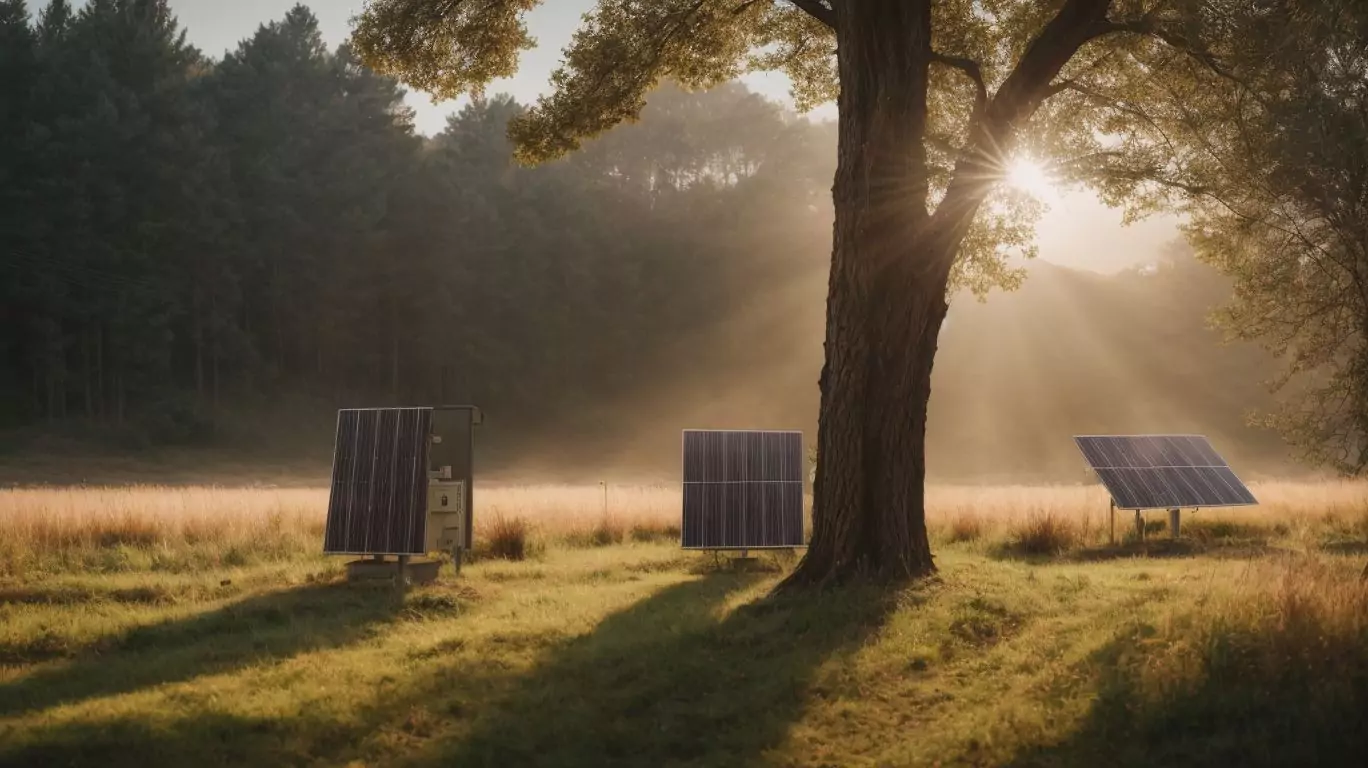Solar Power vs. Traditional Electricity: A Cost Comparison – Which is More Economical?

Have you ever wondered about the true cost of the electricity you use in your home? Solar power has become an increasingly popular alternative to traditional electricity, but many people are still unsure about its affordability. In this article, we will delve into the cost differences between solar power and traditional electricity to help you make an informed decision.
What Is Solar Power?
Solar power is the process of converting sunlight into electricity through the use of solar panels or photovoltaic cells. This type of renewable energy source harnesses the sun’s energy to generate electricity without releasing harmful emissions.
Solar power systems typically include solar panels that capture sunlight and convert it into direct current (DC) electricity, which is then converted into alternating current (AC) electricity through an inverter. This makes solar power a practical option for both homes and businesses, providing numerous benefits such as reduced reliance on fossil fuels, lower electricity bills, and a positive impact on the environment. It is a sustainable and clean energy solution that can be utilized in a variety of applications, from powering buildings to supplying electricity in remote areas without access to the grid.
With advancements in technology and decreasing costs, solar power is a rapidly growing industry and an increasingly viable option for individuals and organizations worldwide.
What Is Traditional Electricity?
Traditional electricity is the conventional method of producing and distributing electrical power through the burning of fossil fuels, such as coal, natural gas, and oil. It has been the primary source of energy for residential, commercial, and industrial purposes for many years. This process involves burning fuel to create steam, which then turns a turbine connected to a generator, producing electricity. The electricity is then transmitted through power lines to homes and businesses for various applications.
However, as the world shifts towards cleaner and more sustainable energy sources, traditional electricity is being challenged by renewable alternatives like solar power. Solar power uses photovoltaic (PV) panels to harness energy from the sun, providing a clean and renewable source of electricity. This transition offers numerous benefits, including reduced greenhouse gas emissions, lower operating costs, and long-term energy sustainability.
How Do Solar Power and Traditional Electricity Differ?
When it comes to powering our homes and businesses, there are two main options: solar power and traditional electricity. While both provide the necessary energy, these two sources differ in many aspects. In this section, we’ll be taking a closer look at the differences between solar power and traditional electricity. We’ll explore the source of energy for each, the environmental impact, and their availability in different areas. By understanding these differences, we can better evaluate which option may be best suited for our individual needs.
1. Source of Energy
When comparing solar power and traditional electricity, the source of energy is a key difference. Here are the steps to understand this aspect:
- Solar Power: Solar energy is derived from the sun’s radiation. Photovoltaic (PV) panels convert sunlight directly into electricity through the photovoltaic effect. This renewable energy source is abundant and available worldwide.
- Traditional Electricity: Traditional electricity is generated through various sources, including fossil fuels like coal, natural gas, and oil. These non-renewable resources are burned to produce steam, which drives turbines connected to generators.
To illustrate the impact of solar power, consider the story of a family who installed solar panels on their roof. By harnessing the power of the sun, they were able to generate electricity for their home, reducing their reliance on traditional electricity. This not only saved them money but also significantly reduced their carbon footprint, contributing to a cleaner and more sustainable environment. The switch to solar power was a transformative step towards a greener future.
2. Environmental Impact
The environmental impact is a crucial factor when comparing solar power and traditional electricity. Here are three key differences in terms of their impact on the environment:
- Source of Energy: Solar power relies on harnessing sunlight to generate electricity, while traditional electricity is primarily generated from non-renewable sources like coal, natural gas, and oil. Solar power produces clean energy, emitting zero greenhouse gases during operation, whereas traditional electricity generation releases significant amounts of carbon dioxide and other pollutants.
- Pollution and Emissions: Solar power has a minimal environmental footprint, with no air or water pollution associated with its operation. In contrast, traditional electricity generation contributes to air pollution, acid rain, and water contamination through the emission of harmful pollutants such as sulfur dioxide, nitrogen oxides, and particulate matter.
- Land and Habitat Impact: Solar power systems require land for installation, but they can be built on already disturbed land or integrated into existing structures, minimizing habitat disruption. Conversely, traditional electricity generation often involves mining for fossil fuels, leading to habitat destruction, deforestation, and ecosystem disruption.
Considering their environmental impact, solar power emerges as a cleaner, more sustainable energy option compared to traditional electricity.
3. Availability
Availability is a key factor to consider when comparing solar power and traditional electricity. Here are some important points to understand about their availability:
- Solar Power:
- Solar power is readily available as long as there is sunlight.
- It is most abundant in regions with high solar irradiation, such as deserts or tropical areas.
- However, solar power can still be harnessed in areas with lower solar irradiation, though it may be less efficient.
- Advancements in technology have also made it possible to generate solar power even in cloudy or overcast conditions.
- Traditional Electricity:
- Traditional electricity is easily accessible through power grids in most areas.
- It is not reliant on weather conditions or sunlight.
- However, the availability of traditional electricity may be affected by power outages or infrastructure limitations.
- In remote or rural areas, the availability of traditional electricity may be limited or nonexistent.
Considering the availability of solar power and traditional electricity is crucial in determining the most suitable energy source based on location and accessibility.
What Are the Costs of Solar Power and Traditional Electricity?
When it comes to powering our homes and businesses, there are two main options: solar power and traditional electricity. While solar power has become increasingly popular in recent years, many still wonder about the costs of this alternative energy source compared to traditional electricity. In this section, we will examine the various costs associated with both solar power and traditional electricity, including installation costs, maintenance costs, and ongoing energy costs. By the end, you will have a better understanding of the financial implications of these two power sources.
1. Installation Costs
When considering the costs of installing solar power, there are several steps involved that contribute to the overall expenses. Here is a list of steps to consider:
- Site Assessment: A professional will assess your property to determine its suitability for solar installation and evaluate any potential obstacles or modifications needed.
- Design and Engineering: Once the site assessment is complete, a solar system design and engineering plan will be created based on your energy needs and site conditions.
- Permitting and Inspections: Before installing the solar system, you will need to obtain necessary permits from local authorities. Inspections may also be required during and after installation.
- Equipment and Materials: The cost of solar panels, inverters, mounting systems, and other necessary equipment will contribute to the overall installation costs.
- Labor and Installation: It is recommended to hire a professional solar installer to handle the installation for a safe and efficient process.
- Connection to the Grid: Depending on your location, there may be fees associated with connecting your solar system to the electric grid.
- Additional Costs: Other factors that can affect installation costs include roof repairs or upgrades, electrical upgrades, and any necessary tree trimming or removal.
It’s important to note that installation costs can vary depending on factors such as system size, location, and specific requirements. Obtaining multiple quotes and exploring available incentives or financing options can help ensure that you get the best value for your solar installation investment.
2. Maintenance Costs
- Regular cleaning: Regularly clean the solar panels to remove dirt, debris, and any other buildup that may decrease their efficiency. This can be done with water and a soft brush or a specialized solar panel cleaning kit.
- Inspection and maintenance: Schedule periodic inspections to check for any damage or issues with the solar panels or their components. This can help identify and address any potential problems early on.
- Inverter maintenance: The inverter is an important component of a solar power system and may require maintenance or replacement over time. Regularly check the inverter for any issues and ensure it is functioning properly.
- Battery maintenance (if applicable): If your solar power system includes batteries for energy storage, proper maintenance is necessary. This may involve checking the battery charge levels, cleaning battery terminals, and replacing batteries when needed.
- Professional servicing: In addition to regular maintenance tasks, it is recommended to have professional servicing of your solar power system every few years. This can help identify any major issues or necessary repairs that may not be apparent during routine maintenance.
- Maintenance Costs: It is important to factor in maintenance costs when considering a solar power system. Regular cleaning, inspections, and professional servicing may incur additional expenses, but can help ensure the longevity and efficiency of your system.
3. Energy Costs
Energy costs play a crucial role when comparing solar power and traditional electricity. Here are some factors to consider:
- Generation costs: Solar power relies on capturing sunlight and converting it into electricity, which is a free and abundant resource. Traditional electricity, on the other hand, requires the burning of fossil fuels or nuclear reactions, which come with associated costs.
- Operational costs: Solar power systems have minimal operational costs since they require little maintenance once installed. Traditional electricity generation involves ongoing expenses for fuel procurement, maintenance, and infrastructure upgrades.
- Storage costs: Solar power systems may require additional costs for energy storage solutions, such as batteries, to ensure a continuous power supply during cloudy or nighttime conditions. Traditional electricity does not have this storage requirement.
Considering these factors, solar power has lower energy costs in the long run compared to traditional electricity. Although the initial investment for solar power may be higher, the savings in energy costs over time make it a more cost-effective option.
What Are the Benefits of Using Solar Power?
As the world becomes more environmentally conscious, the popularity of solar power continues to rise. But what exactly are the benefits of using solar power compared to traditional electricity? In this section, we will delve into the advantages of solar power, including lower energy costs, its renewable nature, and its positive impact on the environment through reduced carbon emissions. By the end, you’ll have a better understanding of why so many are making the switch to this alternative energy source.
1. Lower Energy Costs
One of the advantages of utilizing solar power is the decrease in energy costs. By harnessing the sun’s energy, you can significantly reduce your monthly electricity bills. Here are some steps to help you achieve lower energy costs with solar power:
- Install solar panels on your roof or in a sunny area of your property. Make sure they are properly positioned to maximize sunlight exposure.
- Connect your solar panels to an inverter that converts the sun’s energy into usable electricity for your home.
- Install a net metering system to measure the electricity generated by your solar panels and the electricity you consume from the grid. This allows you to receive credits for any excess solar energy you produce.
- Utilize energy-efficient appliances and LED lighting to further decrease your energy consumption.
- Monitor your energy usage and adjust your habits to optimize energy efficiency.
By following these steps, you can enjoy the benefits of lower energy costs while also reducing your carbon footprint and contributing to a more sustainable future.
2. Renewable Energy Source
Renewable energy sources, such as solar power, have gained significant attention due to their environmental benefits and long-term sustainability. Here are some key steps in understanding the concept of renewable energy sources:
- Evaluating the source: Solar power harnesses energy from the sun, making it an abundant and inexhaustible source of power.
- Energy generation: Photovoltaic (PV) panels convert sunlight into electricity through the photovoltaic effect.
- Efficiency: Continuous advancements in solar technology have resulted in increased efficiency, enabling more energy production with fewer panels.
- Longevity: Solar panels have a lifespan of 25-30 years, providing a substantial amount of clean energy over their lifetime.
- Environmental impact: Solar power produces no greenhouse gas emissions, reduces reliance on fossil fuels, and helps combat climate change.
- Grid integration: Solar energy can be integrated into existing electricity grids, providing power to homes, businesses, and communities.
- Storage solutions: Innovations in batteries allow excess solar power to be stored and used during the night or on cloudy days.
By embracing renewable energy sources like solar power, we can transition towards a sustainable and greener future.
3. Reduced Carbon Footprint
Solar power provides numerous benefits, including a reduced carbon footprint. By harnessing energy from the sun, solar power generates electricity without emitting harmful greenhouse gases. Here are the steps that contribute to the reduced carbon footprint of solar power:
- Greenhouse gas reduction: Solar power systems do not release carbon dioxide, methane, or other greenhouse gases during operation, unlike traditional electricity generation methods.
- Renewable energy source: Solar power relies on the sun, a renewable resource that will not deplete over time. This eliminates the need for burning fossil fuels, which emit large amounts of carbon dioxide.
- Offsetting carbon emissions: Generating electricity from solar power can help offset carbon emissions from other sources. The more solar power used, the less reliance on fossil fuels.
By adopting solar power, individuals and businesses can significantly contribute to reducing their carbon footprint and combating climate change. Additionally, governments and organizations are encouraging the transition to solar power to achieve global carbon reduction goals.
What Are the Disadvantages of Using Solar Power?
While solar power has become increasingly popular as a renewable energy source, it is not without its drawbacks. In this section, we will discuss the disadvantages of using solar power compared to traditional electricity. From the initial investment required to the limitations of storage capacity, we will examine the various factors that may make solar power a less appealing option for some consumers. However, by understanding these disadvantages, we can make informed decisions about the best energy source for our individual needs and circumstances.
1. Initial Investment
When considering solar power, the initial investment may seem daunting. However, there are steps you can take to plan and manage the costs effectively:
- Research and gather information about solar panel systems, including their costs and potential savings.
- Get multiple quotes from reputable solar panel companies to compare prices and offerings.
- Calculate your energy needs and determine the size of the solar system required for your home or business.
- Explore available incentives and rebates offered by government programs or local utilities to help offset the upfront costs.
- Consider financing options such as loans or leasing agreements that can help make the initial investment more affordable.
- Consult with a professional solar installer to discuss financing options, system design, and any questions or concerns you may have.
- Create a budget and timeline for the installation process, taking into account any necessary upgrades or modifications to your property.
- Evaluate the long-term benefits of solar power, including potential energy savings, reduced reliance on traditional electricity, and the positive environmental impact.
Remember, while the initial investment may require careful planning, solar power can provide significant cost savings and environmental benefits in the long run.
2. Dependence on Sunlight
Solar power is a renewable energy source that relies on sunlight to generate electricity. However, its effectiveness and availability are dependent on the amount of sunlight it receives. Here are some steps to consider regarding solar power’s dependence on sunlight:
- Assess the location: Determine the amount of sunlight the area receives throughout the year. Regions with more sunlight will have greater solar power potential.
- Analyze the orientation: Consider the orientation of the solar panels to maximize sunlight exposure. Panels facing south typically receive the most sunlight in the Northern Hemisphere.
- Consider seasonal variations: Take into account the seasonal changes in sunlight intensity. Adjustments may be needed to optimize solar power production during different times of the year.
- Account for weather patterns: Understand how weather conditions, such as cloudy days or storms, can affect sunlight availability. Backup energy sources or battery storage systems can mitigate the impact of sunlight variations.
- Monitor energy consumption: Track electricity usage to ensure it aligns with sunlight availability. Adjusting consumption patterns, such as running energy-intensive appliances during peak sunlight hours, can optimize solar power usage.
Remember to consult with solar power professionals to determine the best approach for maximizing your solar power system’s efficiency and overcoming the limitations of dependence on sunlight.
3. Limited Storage Capacity
Solar power has a disadvantage of limited storage capacity compared to traditional electricity, which can impact the availability and reliability of solar energy. However, there are steps that can be taken to address this challenge:
- Invest in energy storage systems: Utilize technologies like batteries to store excess solar energy generated during the day for use during cloudy or nighttime periods.
- Optimize energy consumption: Implement energy management systems to prioritize the use of solar power when it is most abundant and reduce reliance on stored energy.
- Explore grid integration: Connect your solar power system to the electricity grid, allowing you to export excess energy during the day and import electricity when solar generation is insufficient.
It is important to note that storage technologies for solar power are continuously evolving and improving. Researchers are constantly working on developing more efficient and cost-effective storage solutions to address the limited storage capacity challenge. In fact, according to the International Renewable Energy Agency, the global energy storage market is expected to grow by 13% annually through 2030.
Which Is More Cost-effective: Solar Power or Traditional Electricity?
When considering the cost-effectiveness of solar power versus traditional electricity, several factors need to be taken into account. The initial installation cost of solar panels can be high, but over time, the savings on electricity bills can offset this expense. Additionally, solar power systems require minimal maintenance, further reducing costs in the long run. On the other hand, traditional electricity relies on non-renewable resources, which are subject to price fluctuations and supply constraints. Moreover, the environmental impact of traditional electricity generation is significant, leading to additional costs in terms of pollution control and health expenses. In contrast, solar power is clean and renewable, contributing to a greener and more sustainable future. Ultimately, the cost-effectiveness of solar power or traditional electricity may vary depending on individual circumstances and location, but taking into consideration the long-term benefits and positive environmental impact, solar power is often the more cost-effective option.
In 2016, solar power reached a milestone when its cost per kilowatt-hour (kWh) dropped below that of traditional electricity in some regions. This marked a turning point in the global energy landscape, as more households and businesses began to recognize the financial advantages of solar power. Technological advancements and government incentives have further boosted the affordability and accessibility of solar power systems over the years, making them a viable and cost-effective alternative to traditional electricity. As a result, solar power installations have surged, leading to a significant increase in solar energy generation worldwide. Today, solar power continues to gain momentum as a cost-effective and sustainable solution for meeting our energy needs.






